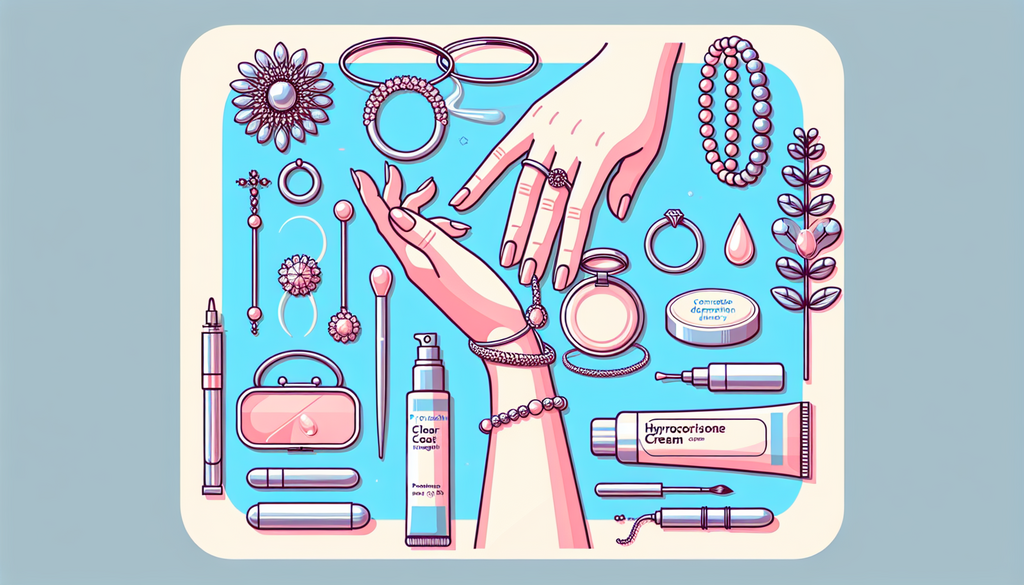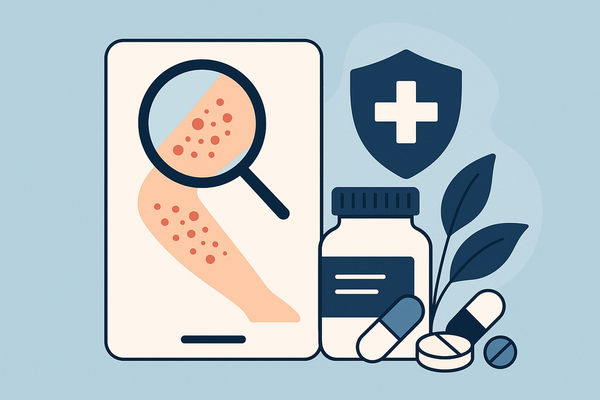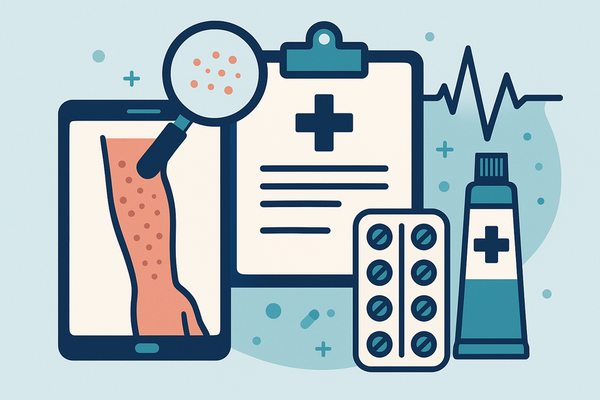Understanding Contact Dermatitis from Jewelry: Causes and Solutions
Learn about contact dermatitis from jewelry, a common allergic reaction caused by metals like nickel. Discover identification, prevention, and treatment options.

Estimated reading time: 10 minutes
Key Takeaways
- Allergen-triggered rashes involve Type IV hypersensitivity and histamine release.
- Nickel and other metals in jewelry are common triggers; choose hypoallergenic options and treat with topical steroids.
- Fragrances and enzymes in detergents can cause contact dermatitis; switch to hypoallergenic detergents and double-rinse.
- Poison ivy rash is best managed by immediate urushiol removal and topical corticosteroids; seek care for severe cases.
- Latex allergy presents as Type I or Type IV reactions; remove latex, switch to nitrile or vinyl, and carry epinephrine if necessary.
- Distinguish hives from contact dermatitis by lesion duration, shape, and mobility to guide treatment.
Table of Contents
- Introduction to Allergen-Triggered Rashes
- Understanding Contact Dermatitis from Jewelry
- Preventing and Treating Allergic Rash from Detergent
- Poison Ivy Rash Treatment
- Latex Allergy: Identification and Management
- Hives vs Rash: Key Differences
- Quick AI Assessment Tool
- Conclusion
Introduction to Allergen-Triggered Rashes
Introduction
Allergen-triggered rashes are skin reactions driven by an abnormal immune response. When harmless substances touch our skin, the body can overreact, causing inflammation. This reaction often involves Type IV delayed hypersensitivity and histamine release.
Contact dermatitis from jewelry is one of the most common forms of allergic contact dermatitis. Metals in rings, earrings, necklaces, and bracelets—especially nickel—can trigger red, itchy patches at contact sites.
Learn more about why you might have a rash on your arm or why you might have a red rash on your neck.
Common symptoms include:
- Redness (erythema)
- Itchiness (pruritus)
- Swelling (edema)
- Blisters or vesicles
- Dry, scaly patches
Frequent triggers:
- Metals such as nickel and cobalt
- Fragrances, dyes, and enzymes in detergents
- Plant oils like urushiol from poison ivy
- Natural rubber latex
Real-world example: A patient developed red, itchy patches under a ring after two weeks. Patch testing confirmed a nickel allergy. Removing the ring and using a steroid cream resolved the rash in ten days.
Understanding Contact Dermatitis from Jewelry
Contact dermatitis from jewelry is a localized allergic reaction where metals meet skin. Nickel is the top culprit, but cobalt and trace nickel in gold or silver can also provoke rashes.
Onset & Presentation
- Timeframe: Symptoms appear 12 hours to several days after first contact.
- Locations: Earlobes (earrings), finger webs (rings), neckline (necklaces).
- Lesion Characteristics: Erythematous papules, tiny vesicles, and chronic lichenification (thick, scaly skin).
Common Allergens in Jewelry
- Nickel – most prevalent allergen.
- Cobalt – present in many low-grade alloys.
- Trace nickel in gold or silver pieces.
Prevention Strategies
- Choose hypoallergenic metals:
- Titanium
- Surgical-grade stainless steel
- 18-karat or higher gold
- Apply a clear barrier coat (nail polish) on contact surfaces; renew every 2–3 days.
- Remove jewelry before hand washing, showering, or heavy perspiration.
- Store jewelry in a dry, cool place to reduce oxidation and metal release.
Treatment Recommendations
- Remove the offending piece immediately.
- Apply a mid-potency topical corticosteroid (e.g., 1% hydrocortisone cream) 2–3 times daily for up to 2 weeks.
- Use cool compresses for 10–15 minutes to soothe itching and reduce inflammation.
- If no improvement in 2 weeks or if you notice yellow crusting, increased pain, or swelling, seek a dermatologist evaluation.
Experience Tip: In my clinic, patients using stainless steel loop earrings instead of nickel cleared rashes within one week.
Preventing and Treating Allergic Rash from Detergent
Allergic rash from detergent is a contact dermatitis triggered by chemicals in laundry or dish soaps. Fragrances, dyes, surfactants, and enzymes can leave residues on fabric that irritate the skin.
Typical Presentation
- Itchy, red patches on torso, arms, or areas in contact with clothing.
- Occasional hives or vesicles; severe reactions can cause peeling or cracking.
- Rash often worsens after wearing freshly laundered clothes.
Prevention Advice
- Switch to fragrance-free, dye-free, hypoallergenic detergents.
- Use an extra rinse cycle or double-rinse load to remove residues.
- Perform a patch test: apply diluted detergent to inner forearm for 24 hours before full use.
- Avoid fabric softeners and scented dryer sheets.
Treatment Steps
- Apply 1% hydrocortisone cream to the rash twice daily until symptoms subside.
- Use bland, fragrance-free emollients (e.g., petrolatum-based creams) after bathing to restore skin barrier.
- Take oral antihistamines (e.g., cetirizine or loratadine) to reduce severe itching.
- If rash spreads, blisters massively, or shows signs of infection (pus, fever), consult a healthcare provider.
Expert Tip: Keeping a laundry diary helps identify which products cause reactions. Note detergent brand, frequency of rash, and severity.
Poison Ivy Rash Treatment
Poison ivy rash treatment centers on removing urushiol oil and relieving symptoms. This contact dermatitis appears in linear or streaked patterns where leaves brushed the skin.
Immediate First-Aid
- Rinse skin (and under nails) with mild soap and cool water within 10 minutes of exposure to remove urushiol oil.
- Wash clothing, tools, and pets that contacted poison ivy.
Over-the-Counter (OTC) Treatments
- Topical corticosteroids: 1% hydrocortisone cream applied 2–4 times daily.
- Calamine lotion: dries blisters and soothes itch.
- Oral antihistamines: diphenhydramine at bedtime reduces itching and aids sleep.
- Colloidal oatmeal baths or cool compresses: calm inflamed skin.
When to Seek Medical Care
- Rash covers a large area (over 20% of body surface).
- Face, genitals or major joints are involved.
- Signs of infection: fever, yellow pus, increasing pain.
- Severe swelling or breathing difficulty.
Prevention Tips
- Learn to identify poison ivy—“Leaves of three, let it be.”
- Wear long sleeves, pants, and gloves when in wooded or overgrown areas.
- Consider barrier creams with bentoquatam before exposure.
Latex Allergy: Identification and Management
Latex allergy rash pictures help recognize both immediate and delayed reactions to natural rubber latex.
Types of Latex Allergy
- Type I immediate hypersensitivity: IgE-mediated, can cause hives, respiratory symptoms, or anaphylaxis.
- Type IV delayed contact dermatitis: T-cell mediated, causes localized rash at contact sites.
Rash Appearance
- Red, swollen, itchy patches or hives where latex touched (hands, wrists).
- Vesicles or bullae in severe contact dermatitis.
- Onset ranges from minutes (Type I) to hours or days (Type IV).
Immediate Management
- Remove all latex products at first sign of rash.
- Wash area with mild soap and cool water.
- Apply cool compress and take an oral antihistamine (e.g., loratadine).
Long-Term Management
- Switch to nitrile or vinyl gloves and latex-free products.
- Inform healthcare providers of your latex allergy.
- Be aware of cross-reactive foods: banana, avocado, chestnut.
- For those with anaphylaxis history, carry an epinephrine auto-injector and wear medical ID.
Hives vs Rash: Key Differences
Understanding hives vs rash difference aids quick self-assessment and proper treatment.
Hives (Urticaria)
- Appearance: Raised wheals with central pallor and red edges.
- Duration: Individual lesions last <24 hours; new wheals can appear elsewhere.
- Triggers: Foods, medications, infections, temperature changes.
- Distribution: Often generalized and migratory.
Other Rashes (e.g., Allergic Contact Dermatitis)
- Appearance: Flat or slightly raised red patches; may have vesicles, scaling, or lichenification.
- Duration: Persistent in one location for days to weeks.
- Triggers: Direct skin contact with allergens like metals, detergents, plants.
- Distribution: Localized to contact site.
Quick AI Assessment Tool
For quick assessment of skin issues like allergic rashes, the AI-powered Rash Detector app can analyze images and provide a preliminary report within minutes.

Conclusion
We’ve explored the mechanisms and management of allergen-triggered rashes, focusing on:
- Contact dermatitis from jewelry – recognize nickel and cobalt reactions, choose hypoallergenic metals, and treat with topical steroids.
- Allergic rash from detergent – switch to fragrance-free detergents, double-rinse, and use corticosteroids.
- Poison ivy rash treatment – remove urushiol, apply topical steroids, and seek care for severe cases.
- Latex allergy rash pictures – identify Type I vs. Type IV reactions, remove latex, and adopt latex-free products.
- Hives vs rash difference – use appearance, duration, and movement to distinguish and guide treatment.
Key preventive tips:
- Patch-test new products on the forearm.
- Choose hypoallergenic materials for jewelry, gloves, and laundry.
- Wear protective clothing outdoors.
- Maintain good hygiene and immediate cleansing after exposures.
For severe, widespread, or persistent reactions, consult a dermatologist or allergist. Early identification and targeted intervention will reduce discomfort and prevent chronic skin issues. Keep this guide handy to recognize and manage common skin allergies quickly and effectively.
FAQ
What is contact dermatitis?
It’s a skin reaction caused by direct contact with an allergen or irritant, leading to redness, itching, and sometimes blisters.
How can I prevent allergic rashes from jewelry?
Choose hypoallergenic metals like titanium or surgical-grade steel, apply a barrier coat, and remove jewelry before water exposure.
When should I seek medical attention for a rash?
See a healthcare provider if the rash covers a large area, shows signs of infection (pus, fever), or doesn’t improve after two weeks of treatment.
How do I distinguish hives from contact dermatitis?
Hives are migratory, raised wheals that vanish within 24 hours, whereas contact dermatitis is fixed, persistent, and may include vesicles or scaling.





